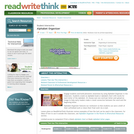
Students use this online tool to create an alphabet chart or pages for an alphabet book.
- Subject:
- Arts and Humanities
- Material Type:
- Activity/Lab
- Interactive
- Provider:
- ReadWriteThink
- Provider Set:
- ReadWriteThink
- Date Added:
- 08/19/2013

Students use this online tool to create an alphabet chart or pages for an alphabet book.
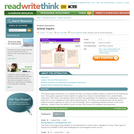
Supporting inquiry-based research projects, the Animal Inquiry interactive invites elementary students to explore animal facts and habitats using writing prompts to guide and record their findings.

Artists are often particularly keen observers and precise recorders of the physical conditions of the natural world. As a result, paintings can be good resources for learning about ecology. Teachers can use this lesson to examine with students the interrelationship of geography, natural resources, and climate and their effects on daily life. It also addresses the roles students can take in caring for the environment. Students will look at paintings that represent cool temperate, warm temperate, and tropical climates.
In this lesson students will: Identify natural resources found in particular geographic areas; Discuss ways in which climate, natural resources, and geography affect daily life; Apply critical-thinking skills to consider the various choices artists have made in their representations of the natural world; Make personal connections to the theme by discussing ways they can be environmental stewards; Identify natural resources found in particular geographic areas; Discuss ways in which climate, natural resources, and geography affect daily life; Apply critical-thinking skills to consider the various choices artists have made in their representations of the natural world; Make personal connections to the theme by discussing ways they can be environmental stewards.

Ever wonder how honey gets from the bee to the table? Join the Bee Cause Project and avid beekeeper, Ted Dennard, on this immersive 360 video to find out just how those amazing bees do it! The National Honey Board has created an amazing look into the life of beekeepers and into the hive. We've created a lesson plan full of resources including science lessons, video links, and a full set of step-by-step printable cards for demonstrating the process of how honey is made!

This lesson plan and assessment takes you on a journey to discover if pollinators find your campus a hospitable home. Core compliant for Grades 3-5, but adaptable to all ages. Are you working with distance learners or in a non-traditional teaching environment? This lesson plan is perfect for you! All you need is a pencil and outdoor space, including sidewalks, local parks, greenways, libraries, and beyond!

Our mission is to inspire the next generation of environmental stewards while protecting our planet's most precious pollinators. The resources we have provided are designed to engage students through observation-based and hands-on learning with a little help from our tiny friends -- the bees! This unit of study has ample resources including teacher guides, video links, material lists, background information, standards mapping, and engaging work for students.
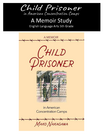
Japanese American Memorial Pilgrimages has developed lessons, supplemental resources, and educational documentary videos to accompany the memoir Child Prisoner in American Concentration Camps by Mako Nakagawa.
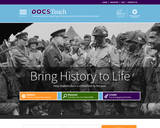
Docs Teach is the online tool for teaching with documents, from the National Archives.
* Choose from thousands of primary sources for use in classroom activities.
* Find and use activities crafted by educators using documents from the National Archives.
* Create your own interactive learning activities.
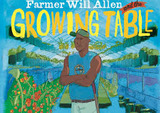
Growing up in Maryland, Will Allen hated farming! After a career in professional basketball and working in a “white shirt job,” Will turned his attention to helping a Milwaukee community learn to grow their own food when he rediscovered a passion for working in the dirt. This book will inspire children and teachers to look at every pot or plot of dirt as a place to grow something.Grade Level: 3rd-5thLexile Level: AD630LGuided Reading Level: TGenre: Nonfiction
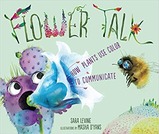
Want to know a secret? Flowers actually ‘talk’ to animals! This beautifully written and illustrated informational text is a delightful way to introduce the symbiotic relationship between plants and pollinators. Full of interesting facts and told from the perspective of a “prickly” cactus, this book will enlighten and entertain your audience.Grade Level: 2nd-5th Lexile Level: 570L Guided Reading Level: Q Genre: Informational Text

In this eight-week module, students learn about new or improved technologies that have been developed to meet societal needs and how those inventions have changed people’s lives. They conduct authentic research to build their own knowledge and teach others through writing. In Unit 1, students read the graphic novel Investigating the Scientific Method with Max Axiom, Super Scientist by Donald B. Lemke as well as several informational articles about inventions that have been developed to meet people’s needs. Students learn about and analyze structures and visual elements authors use to convey complex ideas. Then, they will write a short opinion paragraph about which of the inventions they learned about has been most important to people and why. In Unit 2, students will read The Boy Who Invented TV: The Story of Philo Farnsworth by Kathleen Krull, focusing on how the television was invented to meet societal needs.
Find the rest of the EngageNY ELA resources at https://archive.org/details/engageny-ela-archive .

This inquiry by Amy Johnson, Longview Public Schools, is based on the C3 Framework inquiry arc. Students will look at multiple points of view on an assigned Intolerable Act. After researching primary sources, student will create a newspaper using BEST evidence from their sources that answers the question, "Why would this event the colonists to revolt?"

This Educators Guide provides everything you need to make this virtual field trip a huge success with your students! You will find lists of materials and resources, step-by-step instructions for three complete lessons, journal prompts as well as research topics, supplementary card work, and standards mapping.

In this engaging unit, students will design and plant a square-foot garden that will be their central tool. Through the growing season, they will explore nutrition content in their everyday lives and see how it relates to what they are growing.

In this project-based learning unit, students take responsibility for their learning through active, hands-on engagement, while the teacher acts as a facilitator. Students will learn about ocean garbage patches, the cause, its impact, recycling, and solutions to reduce them. Students will share what they learned to help raise awareness of this environmental issue and promote recycling by creating posters for their school and writing scripts to be read during morning announcements. This project requires background knowledge and understanding of the water cycle and the importance of the ocean to the water cycle. Students should know how to use email and some digital format for presentations.
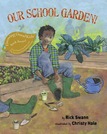
Michael is feeling all alone in a new city and new school until Jesse, a fellow student introduced him to the school garden! Working with new friends, exploring tastes, harvesting vegetables, nicknaminginsects, and solving garden riddles are just a few of the ways that the school garden helps Michael feel like he is growing roots. This Found Poetry style picture book is perfect for introducing a uniquemodern style of poetry while incorporating history, cooking, word study, and a love for the outdoor classroom.Grade Level: 2nd-5thLexile Level: Not availableGuided Reading Level: Not availableGenre: Fiction, poetry

This is a 5th grade writing unit focusing research and informational writing on ugly and weird animals.

Purpose of UnitThe purpose of this Climate Science NTC Project GLAD® unit is a call to action, providing equity of access for all students. Through a model of instruction that promotes language development within core content, the Voices of Hope unit teaches students the science behind climate change and equips them with the tools necessary toward making a positive impact on our planet. This unit was written for 4th - 7th grade.

What if there were no bees? How would it affect our grassland animals? How would it affect humans? This book offers insight into the problems that countless animals and plants face with the potential loss of the bees. Discover just how important this tiny species is to the food web of this ecosystem.Grade Level: 3rd-5thLexile Level: 890LGuided Reading Level: NGenre: Nonfiction
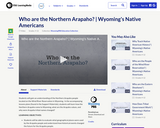
Students will gain an understanding of the Northern Arapaho people located on the Wind River Reservation in Wyoming. In the accompanying lessons plans (found in the Support Materials), students will learn how the Northern Arapaho come to Wyoming, what are the Arapaho values, and why were Arapaho tribal names changed?
LEARNING OBJECTIVES:
Students will be able to evaluate what geographical places were used by the Arapaho people and understand how historical events changed the future for the Arapaho people.
Students will compare and contrast between their social and ceremonial structures.
Students will understand the hierarchy of the Arapaho Tribe.
Students will analyze how their social and ceremonial structures contribute to their cultural identity.